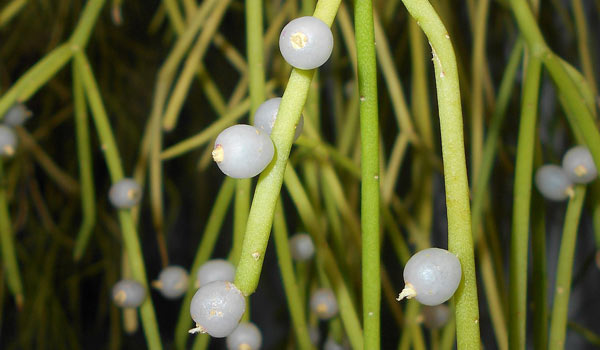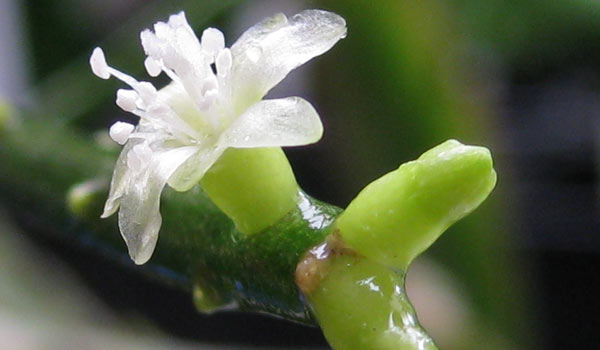Mistletoe Cactus Care (Rhipsalis Baccifera)

Scientifically named Rhipsalis baccifera, the mistletoe cactus or the chain cactus is a peculiar plant among cacti. Apart from its magical appearance and lovely mistletoes, which are actually white berries, it is the only cactus that you can find outside of America in Sri Lanka and Africa.
Thanks to its beautiful and delicate shape, this plant is perfect for growing in hanging baskets. And in this article, we are going to tell you all you need before adding a mistletoe cactus to your home.
Rhipsalis Baccifera Info
The chain cactus is native to rainforests in warm regions found in Florida, Mexico, Peru, and Brazil. Therefore, its requirements and care are different from many other cacti that are originally from hot, sunny, and arid zones. For example, it thrives best in shade to partial shade spots, needs moisture and dim light.
Similar to other tropical succulents, you can find the mistletoe cactus on rock crevasses, trees, or in branch nooks in their natural habitat, with thin stems that can grow up to 30 feet long and 6 feet when grown indoors (you can always prune it). There are no thorns on the thick skin of these stems, but there are imperceptible bumps that can be felt.
Mistletoe Cactus Bloom
This spineless cactus does not produce large and showy blooms. Instead, it blesses us with tiny green-white flowers. Mistletoe cactus blooms appear in late winter or spring and bloom periodically throughout the year.
The Mistletoe cactus flower is later followed by edible fruits that resemble berries on a mistletoe, hence the name. When ripen, these berries offer a sweet and delightful taste.
Is Mistletoe Cactus Toxic?
If you have children or pets, you can keep a Rhipsalis in your home without worrying, as it is generally non-toxic to humans, cats, and dogs.
Mistletoe Cactus vs. Pencil Cactus
It is common to mistake Rhipsalis baccifera with the pencil cactus or Euphorbia tirucalli due to their undeniable resemblance. However, the pencil cactus is actually not a cactus and unlike the chain cactus, it has a tree-like habit and grows up to the ceiling; even when you grow it indoors.
And as you can tell by their scientific names, they are from different genus as well. In the next part, we will introduce mistletoe cactus varieties briefly so you know your chain cactus better.

Mistletoe Cactus Varieties
Here are some of the most popular types of this cactus:
- Brazilie Mistletoe (Rhipsalis teres prismatica ‘Brazilie’); that you can identify with its fine-textured narrow stems.
- Capilliformis Mistletoe (Rhipsalis capilliformis); also known as the old man’s beard, this plant is best known for its small and trailing stems.
- Elliptica Mistletoe (Rhipsalis elliptica); that probably has the most flattened stems among mistletoe cactus varieties, making it similar to the Christmas cactus.
- Micrantha Mistletoe (Rhipsalis micrantha); is another variety with flattened and fleshy stems, but not as flattened as the Elliptica.
- Prismatica Mistletoe (Rhipsalis teres prismatica); is another variety with charmingly thin stems.
- Red Mistletoe Cactus (Pseudorhipsalis ramulosa); with flat red stems and green-white flowers, this is a very famous variety. Fortunately, red mistletoe cactus care is not different than the original chain cactus.
- Burches Mistletoe (Rhipsalis burchellii); simply another easy-to-grow variety with cascading branches and white blooms, perfect for hanging baskets.
- Drunkard’s Dream Mistletoe (Rhipsalis salicornioides); with exotic and twisting stems, the fact that where this plant gets its name from, remains a mystery.
- Ewaldiana Mistletoe Cactus (Rhipsalis ewaldiana); unlike other mistletoe cactus varieties, this type has orange-ish stems when young. As they mature, they take on vibrant green color and become small-textured.
- Pilose Mistletoe (Rhipsalis pilocarpa); as another fun variety, it has stems with soft white hair and tiny blooms in white.
Mistletoe Cactus Care
This plant has a good reputation for being low-maintenance. These are the requirements of this eye-catching plant:
- Water: In spring and summer, let the soil mix dry out slightly before watering again. Also, water less in cold months.
- Light: This tropical cactus will grow happily if you provide it with indirect light throughout the year. However, in summer, protects it from direct and harsh sunlight so the stems do not turn red and shrivel. For mistletoe cactus care indoors, if such spot is not available, place it under grow lights.
- Soil: You can prepare the right mistletoe cactus soil at home by combining one part peat moss-based soil mix and one part fir bark. After filling the container, do not pack the soil down, as this cactus likes a little air around its roots just like in the wild. Any other rich and well-draining mix would also work.
- Temperature: The chain cactus prefers temperature between 70 °F to 75°F during the day and 60 °F to 70 °F during night times.
- Humidity: Since this plant comes from rainforests, there is no surprise that it needs high levels of humidity. If you have one of these cacti indoors, mist it every once in a while to provide the needed humidity especially in the winter (as indoor air can become extremely dry). You can also use a humidity gauge to maintain 50% humidity around your mistletoe cactus.
- Feeding: You can fertilize once a month April to September with special cacti and succulents fertilizer to encourage growth.
- Diseases: Root rot can be the main problem for your plant. Wilting stems, black and mushy stems, and stems dropping are the main signs of this problem. To solve this problem, cut back on watering or repot your cactus into rich and well-draining soil.
- Pests: Mealybugs and their white cottony masses are the main issues. If they attacked your beloved plant, use neem oil or insecticidal soap to kill them using the product’s instructions.
- Repotting: Every few years, your chain cactus would appreciate repotting and fresh soil. Use a container that is one size larger, and be gentle when handling the plant.
- Pruning: This plant needs minimum pruning. You can prune your cactus every time it grows to a size more than you prefer, or when you find broken stems.

Mistletoe Cactus Propagation
To grow a new Rhipsalis, it is best to wait until spring or summer. When the time comes, you are ready for mistletoe cactus propagation. Follow these steps:
- Cut a 4 to 6-inch long section from the hanging stems. Or use one of the stems that fall off your plant.
- Leave the cutting in a spot with enough light (which is also reasonably) and wait for it to callus over for a couple of days. When the wound looks dry, you can plant the cutting.
- Fill a small pot with drainage holes with peat-free organic compost. Plant a third or half of the cutting in the soil from the callused side.
- Place the pot in a warm location with bright indirect light, and water it when the compost surface is dried out. When the root system forms completely (in several months), you can treat your plant as a mature one.
You can also propagate new plants using seeds. If you have access to mistletoe cactus blooms and fruits, break the ripened fruits open and harvest the tiny seeds.
For mistletoe cactus propagation using seeds, prepare a container with drainage holes, and follow the instructions below:
- Fill the container with moist and well-draining potting soil, and plant the seeds about 1/8 of an inch deep in it. Note that seed-starting mixes are also a good choice.
- Place the container in a warm location, and keep the soil moist but not soggy until the seeds germinate (which will take about two to six weeks).
- When the seeds germinate, let them grow in the same container for several months. Once they are large enough to be transplanted without any problem, plant them into a larger container.
It is a joy to grow all mistletoe cactus varieties. If you are a true cactus enthusiast, we recommend complementing this plant with variegated baby jade; or contrasting its delicate look with dog tail cactus’ texture.
- In this post:
- Rhipsalis Baccifera Info
- Mistletoe Cactus vs. Pencil Cactus
- Mistletoe Cactus Varieties
- Mistletoe Cactus Care
- Mistletoe Cactus Propagation



